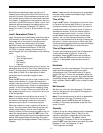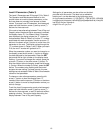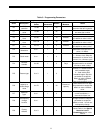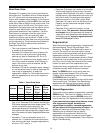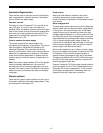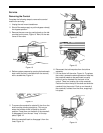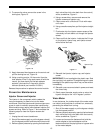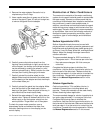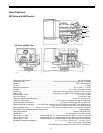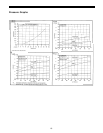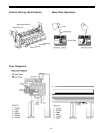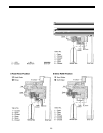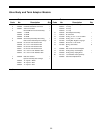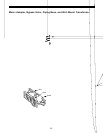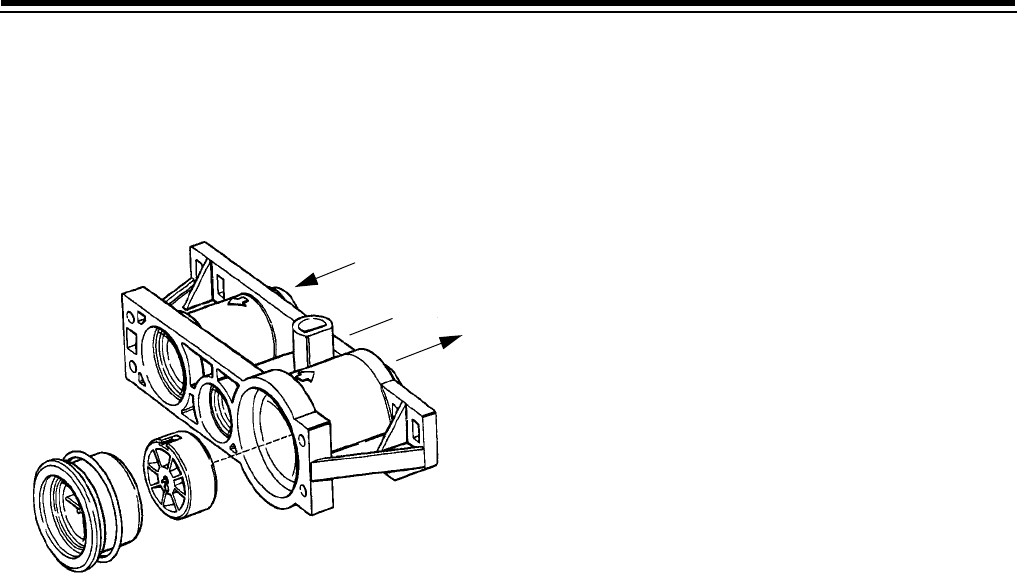
16
4. Remove the meter adapter. Be careful not to
misplace any of the O-rings.
5. Use a needle-nose pliers to grasp one of the four
vanes of the gland, Figure 18, and pull straight out
to remove the gland from the adapter.
Figure 18
6. Carefully remove the turbine wheel from the
housing. Use a toothbrush to lightly scrub the iron
off the magnet. Iron buildup on the wheel surfaces
can be removed by soaking the wheel in a mild
sodium hydrosulfite (e.g., RoVer*) solution for a few
minutes, then flushing thoroughly with water.
7. Carefully reinstall the turbine wheel into the
adapter. Make sure that the shaft of the wheel seats
into the bearing of the adapter and that the dimple
on the wheel faces you.
8. Carefully reinstall the gland into the adapter. Make
sure that the shaft of the wheel seats into the
bearing of the gland. Press the gland all the way in
and check that the wheel rotates freely.
9. Reinstall the meter adapter, O-rings, piping boss or
bypass valve. Tighten all fasteners and turn on the
water supply or put the bypass valve(s) into the
service position. Purge the air out of the system.
To check for proper meter operation, open a
downstream faucet and observe the water flow
indication (flashing colons on time display) on the
control display.
*RoVer is a trademark of Hach Chemical Company.
Disinfection of Water Conditioners
The construction materials of the water conditioning
system do not support bacterial growth or contaminate
the water supply. However, we recommend that the
conditioner be disinfected after installation and before
the conditioner is used to treat potable water. In
addition, a conditioner can become fouled with organic
matter during normal usage or with bacteria from the
water supply. Periodic disinfection is recommended for
all conditioners. Use one of the following methods of
disinfection based on operating conditions, style of
conditioner, type of ion exchanger, and disinfectant
available.
Sodium Hypochlorite 5.25%
Sodium Hypochlorite solutions can be used with
polystyrene resin, synthetic gel zeolite, greensand, and
bentonites and are available under trade names such
as Clorox, Linco, Bo Peep, White Sail, and Eagle Brand
Bleach. Adjust the dosage if stronger commercial
solutions are used.
The recommended dosage for 5.25% solutions is:
•
Polystyrene resin: 1.2 fluid ounces per cubic foot.
•
Non-resinous exchangers: 0.8 fluid ounce per
cubic foot.
Complete the following steps to disinfect the
conditioner: Add the sodium hypochlorite solution to
the brine well of the brine tank. Make sure that the
brine tank has water in it so the solution is carried into
the conditioner. Proceed with normal regeneration.
Refer to the
Manual Regeneration
section in this
manual.
Calcium Hypochlorite
Calcium hypochlorite, 70% available chlorine, is
available in several forms including tablets and
granules. These solid materials can be used directly
without dissolving before application.
The recommended dosage for calcium hypochlorite is
two grains (approximately 0.1 ounce) per cubic foot.
Complete the following steps to disinfect the
conditioner: Add the calcium hypochlorite solution to
the brine well of the brine tank. Make sure that the brine
tank has water in it so the solution is carried into the
conditioner. Proceed with normal regeneration. Refer to
the
Manual Regeneration
section in this manual.
Inlet
Outlet
Drain



